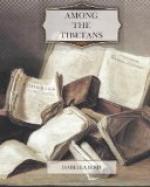As the winter is the busiest season in mission work, so it is the great time in which the lamas make house-to-house peregrinations and attend at festivals. Then also there is much spinning and weaving by both sexes, and tobogganing and other games, and much drinking of chang by priests and people. The cattle remain out till nearly Christmas, and are then taken into the houses. At the time of the variable new year, the lamas and nuns retire to the monasteries, and dulness reigns in the valleys. At the end of a month they emerge, life and noise begin, and all men to whom sons have been born during the previous year give chang freely. During the festival which follows, all these jubilant fathers go out of the village as a gaudily dressed procession, and form a circle round a picture of a yak, painted by the lamas, which is used as a target to be shot at with bows and arrows, and it is believed that the man who hits it in the centre will be blessed with a son in the coming year. After this, all the Kylang men and women collect in one house by annual rotation, and sing and drink immense quantities of chang till 10 p.m.
The religious festivals begin soon after. One, the worshipping of the lamas by the laity, occurs in every village, and lasts from two to three days. It consists chiefly of music and dancing, while the lamas sit in rows, swilling chang and arrack. At another, which is celebrated annually in every house, the lamas assemble, and in front of certain gods prepare a number of mystical figures made of dough, which are hung up and are worshipped by the family. Afterwards the lamas make little balls which are worshipped, and one of the family mounts the roof and invites the neighbours, who receive the balls from the lamas’ hands and drink moderately of chang. Next, the figures are thrown to the demons as a propitiatory offering, amidst ‘hellish whistlings’ and the firing of guns. These ceremonies are called ise drup (a full life), and it is believed that if they were neglected life would be cut short.
One of the most important of the winter religious duties of the lamas is the reading of the sacred classics under the roof of each householder. By this means the family accumulate merit, and the longer the reading is protracted the greater is the accumulation. A twelve-volume book is taken in the houses of the richer householders, each one of the twelve or fifteen lamas taking a page, all reading at an immense pace in a loud chant at the same time. The reading of these volumes, which consist of Buddhist metaphysics and philosophy, takes five days, and while reading each lama has his chang cup constantly replenished. In the poorer households a classic of but one volume is taken, to lessen the expense of feeding the lamas. Festivals and ceremonies follow each other closely until March, when archery practice begins, and in April and May the people prepare for the operations of husbandry.




